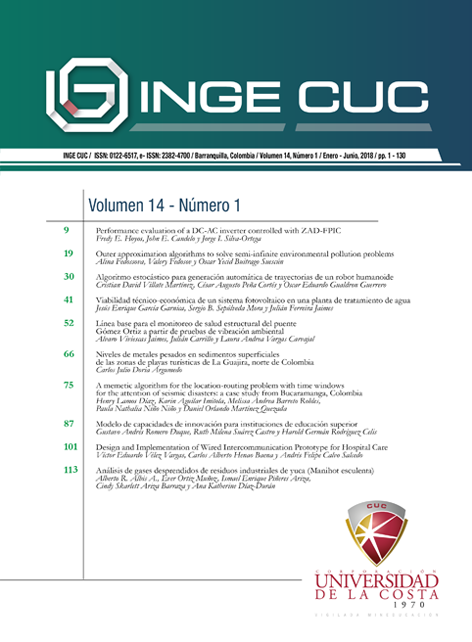Operational failure analysis of a hydropneumatic system in a hospital facility
DOI:
https://doi.org/10.17981/ingecuc.14.1.2018.14Keywords:
NPSHd, NPSHr, cavitation, pumping, head, suctionAbstract
Introduction: This paper presents the study of the operational failure of a hydro-pneumatic system for the supply of water to a hospital facility.
Objective: Determine the cause or causes for the interruption of the water supply of the hydropneumatics system to the building.
Methodology: The hydraulic characteristic of the pipe system was drawn and compared with the hydraulic characteristic of the hydro-pneumatic system, verifying that it fully satisfied the load and flow requests demanded by the building. Given the presence of noises and vibrations in the suction pipe, the comparison of the required NPSH vs. the available NPSH determined that the current design of the suction pipe is the cause for the hydro-pneumatic system failure.
Results: Three variants for the modification of the design of the suction pipe in order to eliminate the phenomenon of cavitation are proposed. This avoids putting into operation an auxiliary pump that increases energy consumption by 8,760 kWh/year with a cost of 1,839.6 $/year and the insecurity in the water service.
Conclusions: The selected hydro-pneumatic equipment satisfactorily meets the requirements of the installation, except for the design of the suction pipe where the available NPSH is lower than the NPSH required at flow rates higher than 900 l/min, hence, producing the cavitation phenomenon and causing the output of system’s service.
Downloads
References
[2] L. E. Díaz, Y. Mustafá I y L. G. Rios, “Construcción y puesta en marcha de un banco de cavitación para bombas centrífugas pequeñas,” Sci. Tech., vol. 1, no. 30, enero de 2006. http://dx.doi.org/10.22517/23447214.6499
[3] F. B. Cruz, “Análisis de las variables de la cavitación en bombas centrífugas horizontales”, Tesis de pregrado, Instituto Politécnico Nacional, México, D. F., 2013.
[4] Z. Zou, F. Wang, Z. Yao, R. Tao, R. Xiao y H. Li, “Impeller radial force evolution in a large double-suction centrifugal pump during startup at the shut-off condition,” Nucl.Eng. Des., vol. 310, pp. 410–417, diciembre de 2016. http://dx.doi.org/10.1016/j.nucengdes.2016.10.034
[5] B. G. Park, Experimental study of debris head loss through a pressurized water reactor recirculation sump screen after LOCA, Nuclear Engineering and Design, vol. 241, no. 7, pp, 2462–2469, abril de 2011. http://dx.doi.org/10.1016/j.nucengdes.2011.04.013
[6] Z. Han y S. K. Vanapalli, “Relationship between resilient modulus and suction for compacted subgrade soils,” Eng.Geol., vol. 211, pp. 85–97, agosto de 2016. http://dx.doi.org/10.1016/j.enggeo.2016.06.020
[7] P. Cao, Y. Wang, C. Kang, G. Li y X. Zhang, “Investigation of the role of non-uniform suction flow in the performance of water-jet pump,” Ocean Eng., vol. 140, pp. 258–269, Aug. 2017. http://dx.doi.org/10.1016/j.oceaneng.2017.05.034
[8] T. Wu y J. D. Englehardt, “Mineralizing urban netzero water treatment: Field experience for energypositive water management,” Water Res., vol. 106, pp. 352–363, diciembre de 2016. http://dx.doi.org/10.1016/j.watres.2016.10.015
[9] N. D. Karlsen-Davies y G. A. Aggidis, “Regenerative liquid ring pumps review and advances on design and performance,” Appl. Energy, vol. 164, pp. 815–825, febrero de 2016. http://dx.doi.org/10.1016/j.apenergy.2015.12.041
[10] K. K. Botros, J. Geerligs y B. Watson, “Experimental investigation aiming at improving the suction flow capability of a gas expeller,” J. Nat. Gas Sci. Eng., vol. 23, pp. 458–463, marzo de 2015. http://dx.doi.org/10.1016/j.jngse.2015.02.025
[11] J. Colt, P. Plesha y J. Huguenin, “Impact of net positive suction head on the design and operation of seawater pumping systems for use in aquaculture,” Aquac. Eng., vol. 35, no. 3, pp. 239–257, octubre de 2006. http://doi:10.1016/j.aquaeng.2006.03.001
[12] Y. Zhang, S. Hu, J. Wu, Y. Zhang y L. Chen, “Multi-objective optimization of double suction centrifugal pump using Kriging metamodels,” Adv. Eng. Softw., vol. 74, pp. 16–26, agosto de 2014. http://dx.doi.org/10.1016/j.advengsoft.2014.04.001
[13] F. Burlon, D. Micheli, R. Furlanetto, M. Simonato y V. Cucit, “Cavitation Detection and Prevention in Professional Warewashing Machines,” Energy Procedia, vol. 101, pp. 718–725, noviembre de 2016. https://doi.org/10.1016/j.egypro.2016.11.091
[14] G. Carraro, P. Pallis, A. D. Leontaritis, S. Karellas, P. Vourliotis, S. Rech y A. Lazzaretto, “Experimental performance evaluation of a multi-diaphragm pump of a micro-ORC system,” Energy Procedia, vol. 129, pp. 1018–1025, septiembre de 2017. https://doi.org/10.1016/j.egypro.2017.09.232
[15] CRANE, Fluid flow: in valves, accessories and pipes, Mc-Graw-Hill Interamericana, 2011.
[16] Technical Data CN50-200C, Sea Land, Cod: 175128000, (PD) Italia, Disponible en: www.sea-land.it
Downloads
Published
How to Cite
Issue
Section
License
Published papers are the exclusive responsibility of their authors and do not necessary reflect the opinions of the editorial committee.
INGE CUC Journal respects the moral rights of its authors, whom must cede the editorial committee the patrimonial rights of the published material. In turn, the authors inform that the current work is unpublished and has not been previously published.
All articles are licensed under a Creative Commons Attribution-NonCommercial-NoDerivatives 4.0 International License.



 English
English
 Español (España)
Español (España)






















